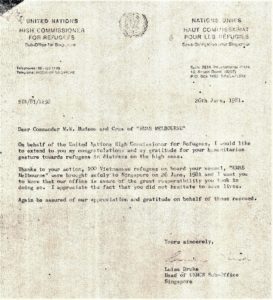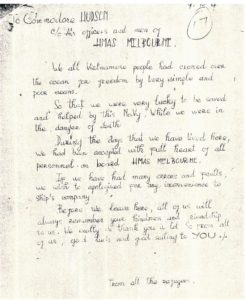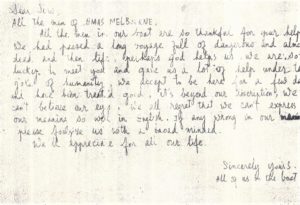On Sunday 21 June 1981 HMA Ships Melbourne and Torrens were participating in Exercise Starfish 81 in the South China Sea when they rescued 99 Vietnamese refugees, now known as ‘MG99’ from their stricken vessel. The following is the formal report of the rescue made by Commodore M.W. Hudson, Commanding Officer HMAS Melbourne to the Flag Officer Commanding HM Australian Fleet. The report was drafted by the then Supply Officer of HMAS Melbourne, Commander John Ingram, RAN.
HMAS MELBOURNE at Sea
9/1/4
Flag Officer Commanding HM AUSTRALIAN FLEET
RECOVERY OF VIETNAMESE REFUGEES
1. The following is a report of actions taken in the recovery of refugees from an Indo Chinese Origin Vessel by HMA Ships MELBOURNE and TORRENS on Sunday 21st June, 1981. Times throughout are time zone G (-7H).
2 At approximately 1807 on Sunday 21st June 1981 while conducting flying operations in the South China Sea in position 9o 19’ N 109o 29’ E, Tracker 851 (piloted by SBLT D. MARSHALL) on a surveillance mission, reported a fishing boat on fire, 9 miles to the west of MELBOURNE. A further report stated that there were from 20 to 50 people on the upper deck, waving to attract attention.
3 The requirement to recover aircraft precluded MELBOURNE from investigating the contact, and at 1814 HMAS TORRENS was detached, with instructions to investigate the fishing boat. MELBOURNE’s Senior Medical Officer, CMDR J. ANDERSON was transferred by helicopter to TORRENS at 1840.
4 At 1902 the first boarding party from TORRENS reported an estimated 90 Vietnamese people embarked in the 15m vessel. The cramped upper deck conditions and fading light delayed inspection of the vessel, made communication with the few English speakers difficult and made an accurate count of the refugees impossible. The refugee’s boat was assessed as being in an unseaworthy condition, with an unserviceable engine, and little food or water onboard. Many of the personnel embarked were suffering from extreme seasickness. On the basis of his boarding party’s report the Commanding Officer HMAS TORRENS recommended that the refugees be embarked, I agreed with the recommendation and after further discussion it was decided to transfer all personnel to HMAS MELBOURNE because of the better facilities onboard and to alleviate any possible interference with HMAS TORRENS’ participation in Exercise Starfish 81. CTG 627.3 endorsed the action being taken. The decision to embark the refugees in MELBOURNE was made at 1950 and the transfer of people commenced immediately, with MELBOURNE in position 1000 yards upwind.
5. The transfers were conducted in moderate sea conditions in a 5 foot swell, using MELBOURNE’s 33 feet utility boat and Gemini seaboats from both MELBOURNE and TORRENS.The eagerness of the Vietnamese people to board the utility boat led to rapid overcrowding and it was decided to transfer the refugees first into a Gemini seaboat, and from there to the utility boat, as the Vietnamese people were loath to board the smaller boat in large numbers. The embarkation was then continued, using both the utility boat and Gemini seaboats to their fair weather carrying capacity.
6. The transfer of refugees from the ship’s boat to MELBOURNE was initially attempted using a “drifting ladder”.The large number of children, and adults unable to climb the ladder unaided meant that another method of bringing them onboard had to be made. A helicopter rescue strop was tried and proved successful. The rate at which people could be brought inboard increased and the last refugees were onboard at 2145, with a total number of 99 personnel having been embarked. HMAS TORRENS was given the task of destroying the refugees’ boat and MELBOURNE proceeded to the south.
7. Accommodation for the refugees was provided on the forecastle, where an assortment of camp stretchers and mattresses were rigged for sleeping berths.Each member of the group was given a brief medical examination, for contagious diseases, and on completion a change of clothing and a meal in the Senior Sailors Cafeteria. Toilet and bathroom facilities were available in the nearby 3A Petty Officers Heads and Baths, which were closed to the Ship’s Company for the duration of the refugees stay.
8. The forecastle was acceptable as a temporary refuge, however the catapult machinery did cause some distress to the young mothers in the group, despite efforts to minimise the impact.
9. On the first evening, written and verbal instructions on matters relating to shipboard life were given to the refugees.Important subjects such as water consumption, non smoking rules, waste disposal and toilet procedures were mentioned. By the second day a notice board written both in Chinese and Vietnamese had been established. On this board was promulgated a plan for the day. The refugees found the board fascinating and followed the instructions on it implicitly.
Interviewing Procedure
10. Information obtained from the refugees at the time of recovery was very scant, and covered.
11. Nationality = Vietnamese.
12. Port of Departure = near Ho Chi Min City (Saigon)
13. Date of Departure = 16th June 1981.
14. On Monday 22nd June a team consisting of LCDR M.C. WEBSTER RAN, LEUT M.J. WRIGHT RAN and WOCOX A. WILLMOTT commenced interviewing the refugees with the assistance of a woman from the group who spoke English, and the aid of translation cards. The emphasis of the interview was to obtain each person’s name, age, sex, occupation and family relationship to other members of the group. Where possible, the address of relatives living outside Vietnam, was also obtained. It was found that single, unattached members of the group were easily dealt with, while family units provided the interviewers with a more complex problem. There was difficulty differentiating which people actually formed the family, and a reluctance on the part of individual family members to talk with the interviewers without the company of other relatives.
15, Efforts were made to obtain details from the Master of the vessel and the interpreters. Questions related to point of departure, sightings of other ships and boats, intended destination and the like. However, details were initially sketchy, primarily as a result of language difficulties and their mental confusion. A surprising feature was that they were a composite of Vietnamese and ethnic Chinese drawn from all over Vietnam and consequently outside family groups they did not know each other prior to their departure.
16. At the conclusion of each interview, each refugee was given a plastic name tally to identify them from those who had not been interviewed.Identification photographs of each person, holding a blackboard showing their name, age and a number were entered into a numbered book. All information collected from the refugees was then collated and entered into this book alongside the corresponding photograph. The book was then retained for later reference by immigration officials.
17. The interviewing of all refugees was concluded in the afternoon of Monday 22nd June, and nominal lists were forwarded by signal to Department of Defence (Navy Office).
Victualling
18. No difficulties were experienced in feeding the group, although the first hot meal after their recovery was not popular.Meals provided were those on the ships company menu. Especially popular were eggs, cabbage, fish and chips and apples. The Chinese women were keen to assist with the preparation and the cooking in general, but the absence of protective clothing and their enthusiasm to use temperatures for cooking oil in excess of RAN limits, led to their efforts being discouraged.
Lessons Learned
19. The evolution of embarkation, the interviewing of the refugees and their subsequent stay onboard showed a number of shortcomings in the ship’s planned responses for such an occasion.Those shortcomings are listed below:
Boat Transfer
(1) Most of the transfers were conducted in total darkness, thus there was a requirement to light Gemini seaboats. MELBOURNE employed divers strobe lights attached to the lifejackets of the boats crew. Those lights allowed the bridge to keep an accurate watch on the boats at all times. It was not possible to provide adequate lighting at the initial transfer point on the refugee boat.
(2) Attempts were made to light the refugee boat by the use of signal lanterns, but they failed to provide enough light to assist the boarding party and were used as beacons by the boats returning to the ship.
(3) As already mentioned, the use of the helicopter strop proved to be far superior to the refugees climbing a drifting ladder. The rescue strop eliminated any possibility of people falling back into the water or boat, and it is recommended that this method of embarkation be employed by all ships in similar situations.
Interviewing of Refugees
(1) The necessity of identifying English speakers among the refugees as soon as possible after embarkation is of the utmost importance. It was found that without the aid of an interpreter the task of communicating any information to the Vietnamese was very difficult as many in the group could not read or write thus negating the value of translation cards.
(2) While interviews are being conducted there is a need to keep them away from the remaining group of refugees. This allows the interviewer to ask questions without fear of interjection from those not involved. Any suggestion of interrogation must be avoided as the interview subject quickly becomes reluctant to answer questions.
(3) The interpreter used in the interview stage must understand that it is in the best interest of all members of the group to translate answers exactly as they are given. Without this attitude much information can be lost if the interpreter gives answers that he/she thinks the interviewer would prefer to hear.
(4) If it was found that there is more than one person capable of interpreting for the interview team, it is advantageous to set up a number of interviewing tables, with a list of standard questions, as the refugees can be put at ease more easily on completion of the interviews.
Communications
As is the case in any boat transfer or boarding evolution, good two way communications from ship to boat and ship to boarding party are essential. In this case Shinwa hand held radios were used and proved to be most efficient. There was a problem in protecting the radios from immersion in the prevailing sea conditions and one radio became unserviceable during the evolution. Although the standard leather case attached to the Shinwa is suitable for protection from everyday use, it is of no value in protecting the radio from water damage. It is recommended that some form of water protection be provided for these valuable items.
Messing of Refugees
With such a large number of refugees being embarked and all being victualled from the same cafeteria, it is essential that extra hands be designated to work in these areas. The ninety nine refugees embarked significantly increased the total number of people eating out of the Senior Sailors Cafeteria and greatly taxed its capacity, and a revision of meal hours was necessary. It is suggested that a smaller ship would encounter difficulty accommodating both its own personnel and the extras embarked.
Clothing
Clothing the refugees was a problem as the stores system is not geared to outfitting people of small stature. RAN men’s clothing was far too large (eg shirts became dresses on the women). The women liked plain white T-shirts but were obviously sensitive about their “see through” qualities. What small size sandals the ship had for repayment were issued, but it was not possible to outfit the majority of the group. The most pressing problem was disposable diapers for the infants. This problem was partially overcome by cutting up large white towels.
Disaster Relief Store
While the ship has exercised Disaster Relief and has embarked a type A container, none of this had any relevance to the recovery and care of “boat people”. In fact, the Type A container was not breached in this event, as its contents are geared to totally different civil aid situations. Consequently, the provision of bedding, (in the form of stretchers, mattresses and blankets) clothing and toys to occupy the children was made from those stores already embarked.
The shortcomings listed above were all of a nature that could be overcome by improvisation and did not significantly deter from the recovery operation.A pleasing feature of the entire time the refugees spent onboard was the compassion that in general the ships company showed towards them, and the gracious manner in which inconveniences to the ships company were accepted. There were, however, some reports of a minority expressing doubt as to the wisdom of allowing refugees into Australia. The “White Australia” policy clearly dies hard.
The refugees were disembarked shortly after the ships arrival in Singapore on Friday 26th June 1981. Representatives of the Australian High Commission and the United Nations spoke to the refugees prior to their disembarkation, and Singaporean Quarantine, Health, Security and Immigration officials also conducted their necessary processing at this time. The refugees were taken to the Hawkins Road United Nations refugee camp, Singapore, where they will remain until their departure for Australia and elsewhere.
Contingency plans within the ship for the embarkation of refugees were dependent upon the number of personnel to be embarked.The ninety nine refugees were within MELBOURNE’s capabilities, although any greater number may have proved excessive. The handling of the refugees throughout their time onboard was done in a most professional and pleasing manner.
Annex A is a list of the recommended range of material needed to meet emergencies of this nature.I have also enclosed copies of 3 letters which are self-explanatory
(M.W. HUDSON)
Commodore, RAN
Commanding Officer
Annex A to
HMAS MELBOURNE letter
9/1/4 dated
RECOMMENDED RANGE OF ESSENTIAL MATERIAL
(not normally carried onboard as Loan/Repayment or Canteen stock)
Disposable diapers, eg “Kimbies”
Small size footwear, eg adjustable sandals
Sanitary pads
Small size sheets (for canvas stretchers)
Stretchers and/or thin mattresses
Basic language cards in Vietnamese and Chinese
English – Vietnamese dictionaries
Female underwear, especially disposable pants
Small sizes in clothing, especially vests, shorts, shirts, sweaters, pyjamas and underpants.
Toilet bags containing bath and laundry soap, toothbrushes and paste, comb, mirror, powder, towel, scissors, razor and blades
Education/Occupational therapy type kits – pad, pen/pencil, colouring books, Holy Bible, basic books on Australia (especially the “Way of Life”), sewing kits for repair/alteration to clothing, learning to read in English books.
Vitamin “C” drinks, eg Hi“C” products
Attachment 1
Telephone: 02-2221383
Telegrams: HICOMREF Singapore
SIN/81/1250 26th June, 1981
Dear Commander M.W. Hudson and Crew of “HMAS MELBOURNE”
On behalf of the United Nations High Commissioner for Refugees, I would like to extend to you my congratulations and my gratitude for your humanitarian gesture towards refugees in distress on the high seas.
Thanks to your action, 100 Vietnamese refugees on board your vessel, “HMAS MELBOURNE” were brought safely to Singapore on 26 June, 1981and I want you to know that your office is aware of the great responsibility you took in doing so. I appreciate the fact that you did not hesitate to save lives.
Again be assured of our appreciate ion and gratitude on behalf of those rescued.
Yours sincerely,
Luise Druke
Head of UNHCR Sub-Office Singapore

Attachment 2
Refugee letter of thanks to Commanding Officer HMAS Melbourne

Attachment 3
Refugee letter of thanks to Commanding Officer HMAS Melbourne





